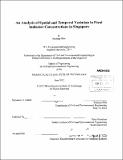An analysis of spatial and temporal variation in fecal indicator concentrations in Singapore
Author(s)
Shin, Suejung
DownloadFull printable version (9.811Mb)
Other Contributors
Massachusetts Institute of Technology. Dept. of Civil and Environmental Engineering.
Advisor
Peter Shanahan.
Terms of use
Metadata
Show full item recordAbstract
This study used extensive measurements of indicator concentrations to describe spatial and temporal patterns of four fecal indicators: E. coli, enterococci, total coliform, and human factor. Twenty twelve-hour time series were examined, with indicator concentrations measured every hour from 8 am to 7 pm. Six stations in Singapore were evaluated, across three land-use categories (high-density residential, low-density residential, commercial), and two sewer-age categories (new, old). The distributions of E. coli, enterococci, and total coliform were roughly lognormally distributed, showing that bacterial indicator concentration distributions are described by the same statistical model in tropical climates as in temperate climates, even with a wide and varied data set. Human factor indicator, for which there is limited preceding literature, was found to be roughly lognormally distributed. There was no obvious time pattern in measured concentrations, except that one hour's concentration roughly correlated with the next 1 to 3 hours' concentrations. This differs from findings from a study by the Public Utilities Board of Singapore that reported a diurnal pattern in total coliform and enterococci concentrations at a single sampling station. This study found, for all indicators but total coliform, that older sewers had a significantly higher indicator concentration than newer sewers. This suggests that sewer leakage likely contributes to fecal contamination. Leaking sewers can explain some of the high indicator concentrations, but lack of diurnal pattern suggests there are more factors at play than just older sewers dispersing contaminants. There are mixed findings with regard to land use. For enterococci, low-density residential areas exhibit significantly different concentrations than high-density residential and commercial areas. For human factor, commercial areas exhibit significantly different concentrations than high-density and low-density residential areas. As human factor might be the best indicator of true pathogen concentrations, this suggests that land use plays a role in differences in concentrations, in agreement with previous studies.
Description
Thesis (M. Eng.)--Massachusetts Institute of Technology, Dept. of Civil and Environmental Engineering, 2012. Cataloged from PDF version of thesis. Includes bibliographical references (p. 53-55).
Date issued
2012Department
Massachusetts Institute of Technology. Department of Civil and Environmental EngineeringPublisher
Massachusetts Institute of Technology
Keywords
Civil and Environmental Engineering.